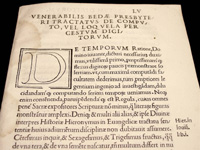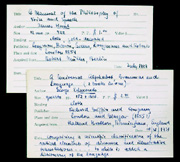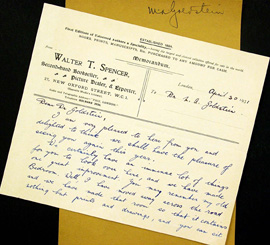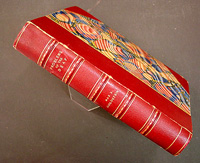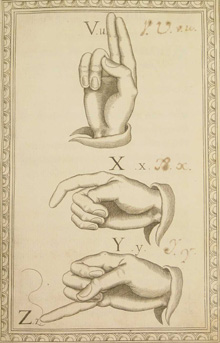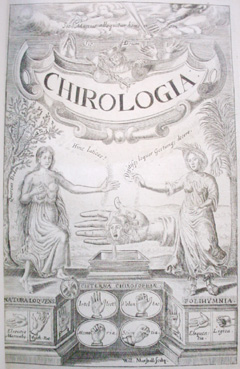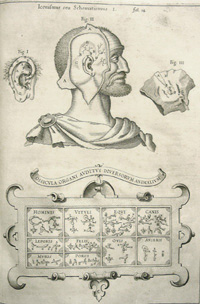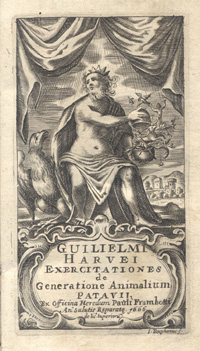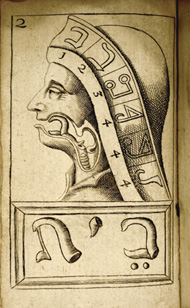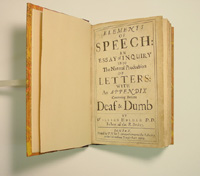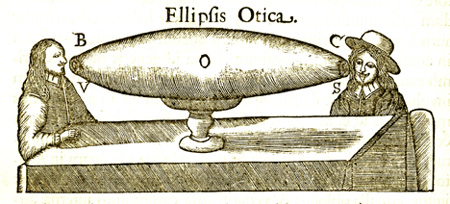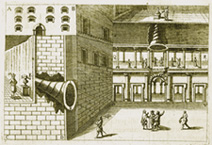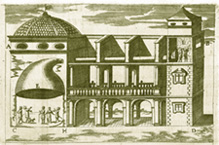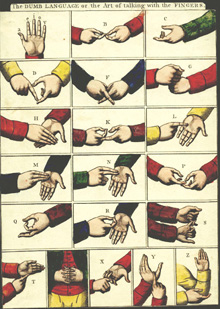The CID – Max A. Goldstein Collection in Speech and Hearing
The CID - Max A. Goldstein Collection in Speech and Hearing comprises more than 900 titles about the anatomy, physiology, and pathology of the ear, nose and throat, deafness, speech and hearing, and even about curious subjects such as physiognomy, phrenology, and chiromancy. Researchers are frequent users of the Goldstein books, and several times a year selections from the collection are displayed.
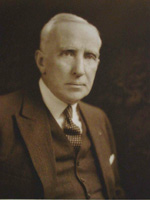 |
| Max A. Goldstein |
Max Aaron Goldstein (1870-1941), a native of St. Louis, attended the Missouri Medical College, graduating in 1892 at the age of only 22. After an internship at St. Louis City Hospital, Dr. Goldstein spent two years in post-graduate work in Europe. His interest in diseases of the ear, nose, and throat led him to the internationally renowned Vienna Polyclinic in 1893 to study with Dr. Adam Politzer, the developer of modern otology. While there, Dr. Goldstein became interested in the work of Professor Victor Urbantschitsch’s methods of improving the education of congenitally deaf children with apparent remnants of hearing by concentrating on stimulation of what he termed a dormant auditory sense.
Dr. Goldstein returned to St. Louis in 1895 to establish his medical practice. Within a year, Goldstein had been appointed chair of Otology at Beaumont Medical College and had founded a new medical journal, The Laryngoscope, which is the earliest and longest continuously published American scientific journal in the field of otolaryngology. He would serve as editor of the journal from its first issue in July 1896 until his death in July 1941.
In 1914 Dr. Goldstein established the Central Institute for the Deaf (CID). The first class consisted of four children and the school was located in rooms above Dr. Goldstein’s medical offices. Within two years construction began on a new separate school building; by the time of Goldstein’s death, CID had established an international reputation, with an enrollment of 300 students from all over the U.S. and several foreign countries.
It was during his European travels, between 1922 and 1939, when Dr. Goldstein assembled the greater part of his rare book collection. Handwritten cards for each volume include the bibliographic data as well as the names of booksellers, places, dates, and prices of purchase – indicating Dr. Goldstein’s collecting habits and at the same time providing a glimpse into the European antiquarian book trade between the world wars.
Dr. Goldstein was an avid collector and not only of books. He collected hearing devices, Indian relics, paintings, prints, butterflies, coins, shells, and stamps; and surely this is an incomplete list of his various collections. In his teaching Dr. Goldstein utilized these objects and artifacts and also during his free time, which he often spent with the children attending Central Institute of the Deaf. A digital exhibit, “Deafness in Disguise: Concealed Hearing Devices of the 19th and 20th Centuries,” features items from Dr. Goldstein’s collection of historic hearing devices.
Memorandum from London bookseller Walter T. Spencer to Dr. Max A. Goldstein, 1931.
It was during his European travels, between 1922 and 1939, that Dr. Goldstein assembled the greater part of his rare book collection. Handwritten cards, as well as letters and memoranda, are also extant with some of the volumes. These ephemeral documents include the bibliographic data of the books together with names of booksellers and with the place, date, and price of the particular purchase. In addition, one can see some evidence of Dr. Goldstein’s collecting habits on these documents and, at the same time, take a glimpse into the antiquarian book trade in Europe between the World Wars.
Dr. Goldstein was an avid collector and not only of books. He collected hearing devices, Indian relics, paintings, prints, butterflies, coins, shells, and stamps as well. In this 1931 memorandum, Walter T. Spencer, Second-hand Bookseller, Picture Dealer & Exporter, is offering drawings, prints, and paintings for sale to Dr. Goldstein.
Max A. Goldstein (1870-1941). Problems of the Deaf. St. Louis: The Laryngoscope Press, 1933.
This work by Dr. Goldstein is a comprehensive overview of various fields related to deafness. The history of deaf education is one of these fields as well as the anatomy and physiology of the hearing organs. Speech defects are also discussed, followed by the role of the nervous system in deafness. The book contains separate chapters for the deaf child and for the deaf adult, and the parent of the deaf child can find instruction in a third section.
Dr. Goldstein included methods of instruction, tabulated records of all American and several foreign deaf schools, and a chapter on societies and periodicals. The final part of the book presents Dr. Goldstein’s own research material preceded by a quite critical “Quacks and Quackeries” section.
Juan Pablo Bonet (1579-1633). Reduction de las letras y arte para enseñar a [h]ablar los mudos. Madrid: Francisco Abarca de Angulo, 1620. (Plate [8]) Copper engraving.
Bonet combined the oral and methodic sign methods of deaf education in his special system, still often referred to as the “Bonet-method.” His manual alphabet was accompanied with pronunciation patterns, which derived from the simplification of the letters as described in the above work. Pictured are the three concluding signs of Bonet’s manual alphabet.
Reduction de las letras … was not translated into English until the late nineteenth century. When the translation was published in 1890, it was without the fine illustrations of the manual alphabet.
Galileo Galilei (1564-1642). Dialogus de systemate mundi . . . Lugduni (Lyons): Sumptibus Ioan. Antonii Huguetan, 1641. (Frontispiece) Copper engraving.
This frontispiece, an illustrated leaf preceding the main title page, shows the three scientists, Ptolemy, Aristotle, and Copernicus, in the midst of their dialogue.
The book contains Galileo’s exposition and proof of the Copernican system, which led to his trial before the Inquisition and sentence to perpetual house arrest. The title was not removed from the “Index librorum prohibitorum” until 1823.
The Dialogo was designed both as an appeal to the public and as an escape from silence. In the form of an open discussion between three friends – intellectually speaking, a radical, a conservative, and an agnostic – it is a masterly polemic for the new science. It displays all the great discoveries in the heavens which the ancients had ignored; it inveighs against the sterility and ignorance of those who defend their systems; it revels in the simplicity of Copernican thought and, above all, it teaches that the movement of the earth makes sense in philosophy, that is, in physics.
Galileo pioneered the study of motion and its mathematical analysis, a field which was taken up by Descartes and Huygens, culminating in the “massive achievements of Newton in dynamics and gravitational astronomy.”
John Bulwer (fl. 1648-1654). Chirologia: or the naturall language of the hand. London: R. Whitaker, 1644. (Engraved title page)
Bulwer equated “gestures” with “language” and used “cheirograms” as natural signs. His direction in deaf education opened the door for an exclusively methodic sign system, which included “manual rhetoric” – chironomia – expressed by “art in the hand.”
Interestingly, Bulwer published another work, Philocophus, in 1648, in which he affirmed the deaf person’s capacity for speech. He also discussed lip-reading, which he described as “hearing with eyes.”
Athanasius Kircher (1602-1680). Musurgia universalis sive ars magna consoni et dissoni in X. libros digesta. Qua universa sonorum doctrina, & philosophia, musicaeque tam theoricae, quam practicae scientia, summa varietate traditur . . . Roma: Ex typographia haeredum Francisci Corbelletti, anno Iubilaei 1650. (Plate 14) Copperplate.
Athanasius Kircher was a true polymath – he was a Jesuit priest, archaeologist, mathematician, biologist, philologist, astronomer, musicologist, Egyptologist, and physicist, who knew Hebrew, Aramaic, Coptic, Persian, Latin, Greek and various modern languages.
Kircher published about forty books covering his wide interests. Musurgia universalis, a kind of musical encyclopedia, was one of his longest works. He discussed the naturalness of music, the links between nature and music, and the families of musical instruments. The text was extensively illustrated by diagrams, tables, and allegorical engravings. All was underscored by Kircher’s belief (essentially medieval) that musical harmony imitated cosmic or God’s harmony.
This illustration shows the anatomy of the human ear, and compares it with the inner workings of ears of different species. The box at the bottom shows the ears of man, cow, horse, dog, leopard, cat, rat, pig, sheep, and goose.
William Harvey (1578-1657). Exercitationes de generatione animalium. Patavii (Padua): Typis heredum Pauli Frambotti, 1666. (Engraved title page)
Harvey’s influential treatise on embryology, first published in 1651, was the primary text to appear on the subject during the 17th century. In this work Harvey rejected the prevailing doctrine of the pre-formation of the fetus. For him, all life developed from the egg, and this was expressed by the frontispiece which depicted Jupiter opening an egg, inscribed with the fundamental dictum of embryology ‘ex ovo omnia,’ from which animals and insects fly. By positing for viviparous animals the same mechanism of reproduction as that observed in oviparous animals, Harvey initiated the search for the mammalian ovum. However, it was not until 1827 that von Baer discovered it.
Besides its pioneering embryology, this work is important for being the first original work on obstetrics by an Englishman.
Franciscus Mercurius van Helmont (1618-1699). Alphabeti verè naturalis Hebraici brevissima delineatio. Sulzbaci (Sulzbach, Germany): typis Abrahami Lichtenthaleri, 1667. (Plate 2) Copper engraving.
Franciscus Mercurius Van Helmont, son of Jean Baptiste van Helmont, is remembered by many different labels, including Quaker, chemist, Cabbalist, physician, and Rosicrucian.
In this work, van Helmont claimed that each letter of the Hebrew alphabet (held to be the primordial language of humanity) was the representation of the positions of the sound-emitting organs. Thus, by learning the correct positions of lips, tongue, palette, larynx etc., a deaf-mute could reproduce sounds and therefore learn to speak without the necessity of hearing. Beyond its Cabalistic implications, this book was considered one of the best lip-reading and deaf-mute teaching manuals. Albrecht Haller (1708-1777), the outstanding physician and bibliographer, wrote: “An extraordinary book . . . you will praise the man who first showed how the human mouth and its organs are adjusted in the pronunciation of each letter, and who also (though not first) taught the deaf to speak.”
William Holder (1616-1698). Elements of speech: an essay of inquiry into the natural production of letters. London: J. Martyn, 1669. (Title page)
In this work, William Holder, an Anglican clergyman and member of the Royal Society, explains the mechanics of articulation with special attention to hearing impaired people. He uses oral and written signs concurrently and applies a manual alphabet together with lip-reading.
Athanasius Kircher (1602-1680). Phonurgia nova sive conjugium mechanico-physicum artis & naturae paranymta phonosophia concinnatum. Kempten: Rudolph Dreherr, 1673. (Four small copperplates and one large woodcut)
Kircher studied at the Jesuit school in Fulda, pursued scientific and humanistic studies at Paderborn, Cologne, and Koblenz, and was ordained at Mainz in 1628. After occupying various academic positions at the universities of Würzburg and Avignon, Kircher settled in Rome in 1634, where he remained for most of his life. He served as professor of physics, mathematics, and Oriental languages at the College of Rome from 1635 until 1643, when he retired to devote himself to archaeological research. Kircher was the first to discover the phonetic value of an Egyptian hieroglyph and he was perhaps the first to believe that disease and plague were caused by infectious living bodies (germs).
While studying at Rome, Kircher built a brass tube leading from his room down to the watchman at the gate to allow for communication of messages. Kircher’s research on sound led him to believe that sound was the earthly counterpoint to heavenly light. To demonstrate this concept, Kircher developed a “hearing lens” or “speaking trumpet” which made distant sounds seem close, just as a telescope does with distant sights.
Phonurgia nova was the first known published book to deal with the nature of sound, acoustics and music. It included all the then-known mathematics and physics concerning sound. The profusely illustrated folio contained the earliest known complete illustrations of devices to convey and amplify sound among the architectural and engineering products related to sound.
The dumb alphabet; or, The art of talking with the fingers. London: [William] Darton, n.d. [not after 1862]. Hand-colored copper engraving.
In 1775 Abbé Charles Michel de l’Epée established the first free school for the deaf in Paris. He created a signed version of spoken French after learning that signs were already being used by a group of deaf people in Paris. De l’Epée believed that deaf people could communicate with each other and with the hearing world through a system of gestures, hand signs, and finger-spelling, thus bridging the gap between the hearing and non-hearing worlds.
Originally director of the school for deaf-mutes at Bordeaux, Abbé Roche Ambroise Sicard succeeded de L’Epée at Paris upon the latter’s death in 1789. In 1815 Thomas Hopkins Gallaudet studied with Sicard in Paris; after several months Gallaudet returned to America with a knowledge of sign language and Laurent Clerc, a deaf sign language instructor from Sicard’s Paris school. Two years later Gallaudet founded the first American school for the deaf in Hartford, Connecticut.
William Darton, Sr. (1755-1819) began an engraving and printing company in London in 1787. Successive generations of Dartons (sons William, Jr., 1781-1854; Thomas, 1783-?; and Samuel, 1785-1840; and grandsons John Maw Darton, 1809-1881, and Thomas Gates Darton, 1810-1887) were also printers and engravers, chiefly of children’s books and maps.
| Back to Top | © 2007-9 Washington University School of Medicine, St. Louis, Missouri |

